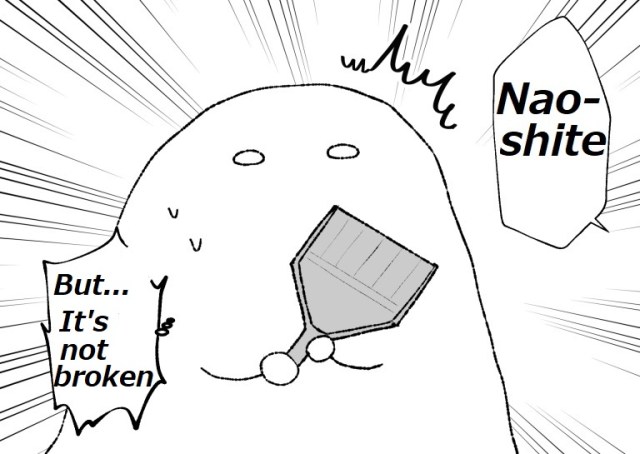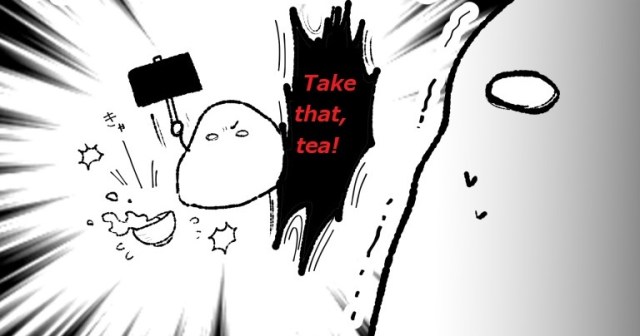
“Beating up tea” and college classes and “fixing” things that aren’t broken.
Our Japanese-language reporter Udonko grew up in a small town in east Japan, so when she graduated from high school and moved to Kyoto to start college, she had some adjusting to do. It wasn’t just the transition from small-town to big-city life or the switch from living with her parents to having her own apartment that Udonko had to get used to, though, because there was another set of new challenges waiting for her in Kyoto: how the people there speak Japanese.
The Japanese language has a number of regional dialects. Over time, the style of speaking in Tokyo and east Japan has become what’s considered hyojungo, or “standard Japanese.” On the other hand, the Kansai region, which includes the cities of Osaka, Kyoto, and Kobe, has its own dialect, called Kansai-ben.
Unlike, for instance, Chinese dialects, the differences between Japanese dialects aren’t so pronounced that speakers of hyujungo and Kansai-ben can’t generally understand each other pretty easily. Core grammar is basically the same across Japanese dialects, as is almost all vocabulary. However, sometimes the same word, or words that are pronounced the same, can have very different meanings in standard Japanese and Kansai dialect. Here are four that tripped up Udonko, and might do the same to you if you’ve been studying/speaking standard Japanese before arriving in Kansai.
1. naosu
In standard Japanese, naosu means “to fix” or “to repair,” and if you want to make it a command, you say naoshite.
So imagine Udonko’s confusion when one of her art class schoolmates handed her a brush that, to Udonko’s eyes, was in perfect condition, and told her “Naoshite.”
This happened shortly after Undoko had moved to Kyoto, and she was completely stumped as to what her classmate wanted her to do. Was there some hidden defect that she just wasn’t noticing? But then she looked around and saw other people putting their art supplies away. It turns out that in Kansai, naosu can also be used the same way as the word katatzukeru (katatzukete in its command form), which means “to straighten up, put away, or organize” something.
2. -kaisei
Kaisei, written in kanji as 回生, means “regenerate,” “resuscitate,” or “resurrect.” It’s pretty easy to trace why, as 回 means, loosely, “iteration” and 生 means “life.”
As a result, Udonko was pretty shocked when she was having a conversation with a guidance counselor at her new school and the administrator recommended a selection of classes for her ikkaisei, or, to Udonko’s east Japan brain, her “first-time life.”
Was…was Udonko’s guidance counselor telling her that she was going to die? Wait, wait, maybe she was just saying that Udonko was going to meet with some grievous injury, and that these classes would be a manageable study load as she…regenerated? Was the school going to teach her how to regrow parts of her body?!?
The truth, though, was far less morbid/awesome. The counselor was simply giving Udonko a list of recommended classes to take as a first-year student. In standard Japanese, a first-year student is called an ichinensei (literally “year-one life”). In Kansai, though, first-year university students can also be called ikkaisei, because it’s their first time making an iteration around that specific school’s academic year.
3. sara
Depending on where/how it’s used in a sentence, sara has a couple of potential meanings, even in standard Japanese. When it’s used as a verb, though, sara generally means a “plate” or “dish,” as in the kind you eat off of.
Yet when Udonko, who’d just finished putting a new protective sheet on her tablet, showed off the recently reinforced gadget to one of her new Kansai friends, that friend smiled and said, “Oh, wow! You made it sara!” which Udonko took to mean “Oh, wow! You made it a plate!”
Kansai in general is known for having a rich culinary culture, and that goes double for Kyoto. But Udonko couldn’t imagine that when it’s time to eat in Kansai, people just lay their electronic devices down on the table and put their food on the screen, regardless of whether or not it’s outfitted with a protective sheet.
Actually, though, in Kansai dialect sara is a way of saying “new” or “a new one.” Unlike the above examples of naosu and kaisei, where the same words can have different meanings depending on the region, Kansai’s “new” sara is a homonym to the “plate” sara, but it’s one that momentarily caused Udonko’s brain to bug out all the same.
4. cha wo shibaku
Udonko had one more food/beverage-related linguistic culture shock after arriving in Kyoto. Cha means “tea,” and shibaku means “to hit, strike, or beat.” So Udonko was baffled, and a little frightened, when a friend nonchalantly suggested that they go cha wo shibaku, or “Beat up some tea.”
The gap between Udonko’s violent vocabulary and cheerful demeanor was unnerving…until Udonko learned that, in Kansai, cha wo shibaku is an alternate way of saying ocha suru, the standard Japanese way of saying “have some tea,” and by extension “take a break and have something to drink (and probably some snacks or sweets).”
▼ It’s worth noting, too, that cha wo shibaku doesn’t carry the same rowdy tone of saying “Let’s crush some beers!” in English, and so Udonko and her friend’s “tea-beating” session ended with no cups shattered or desserts thrown across the room.
Again, Japanese dialects aren’t so different that people from different parts of the country face an actual language barrier, but that makes it all the more jarring when situations like these do pop up. There were far from the last bit of Kansai dialect Udonko encountered for the first time while living in Kyoto, but they’re the ones that left the deepest impression on her, so keep an ear out for them if you’re in region, and keep them in your back pocket if you want to sprinkle them into conversation with your Kansai-ben friends.
Illustrations ©SoraNews24
Top photo: Pakutaso
Insert photo: Pakutaso
● Want to hear about SoraNews24’s latest articles as soon as they’re published? Follow us on Facebook and Twitter!
[ Read in Japanese ]
Follow Casey on Twitter, where he once confused his hyojungo-speaking coworkers by saying “tawan.”
[ Read in Japanese ]






 Does a denim kimono look or feel good? Our kimono neophyte reporter finds out【Photos】
Does a denim kimono look or feel good? Our kimono neophyte reporter finds out【Photos】 Is spending 248,380 yen (US$1,840) on an anime boy doll a wise choice? Our fangirl finds out!
Is spending 248,380 yen (US$1,840) on an anime boy doll a wise choice? Our fangirl finds out! We got a massage and talked games at Tokyo clinic made for and run by otaku
We got a massage and talked games at Tokyo clinic made for and run by otaku How many otaku penlights do you need to survive a blackout in Japan?
How many otaku penlights do you need to survive a blackout in Japan? Touken Rambu chocolates are a treat for anime fans and a test of how well you know the characters
Touken Rambu chocolates are a treat for anime fans and a test of how well you know the characters Foreign tourists to be charged four times more to enter Himeji Castle if local mayor gets his way
Foreign tourists to be charged four times more to enter Himeji Castle if local mayor gets his way Can Kyoto supermarket takeout let you enjoy the local cuisine without fancy restaurant prices?
Can Kyoto supermarket takeout let you enjoy the local cuisine without fancy restaurant prices? Hotel’s amazing breakfast buffet shows why it’s your loss if you skip Nagoya on your Japan trip
Hotel’s amazing breakfast buffet shows why it’s your loss if you skip Nagoya on your Japan trip 5 reasons why foreign tourists should skip Tsukiji and go to a different place in Tokyo instead
5 reasons why foreign tourists should skip Tsukiji and go to a different place in Tokyo instead Osaka man arrested for trying to rob woman with necktie that says “Police”
Osaka man arrested for trying to rob woman with necktie that says “Police” Nintendo unveils new Super Mario travel item merch line just in time for midsummer trips【Photos】
Nintendo unveils new Super Mario travel item merch line just in time for midsummer trips【Photos】 Poisonous blowfish instant ramen on the way from Cup Noodle’s Nissin
Poisonous blowfish instant ramen on the way from Cup Noodle’s Nissin Is Kyoto’s tourist-targeting flavored edamame specialty shop worth its high prices?【Taste test】
Is Kyoto’s tourist-targeting flavored edamame specialty shop worth its high prices?【Taste test】 No-bus Kyoto sightseeing! SoraNews24’s ultimate on-foot guide for Japan’s former capital【Part 2】
No-bus Kyoto sightseeing! SoraNews24’s ultimate on-foot guide for Japan’s former capital【Part 2】 Japan’s new canned chu-hai with fresh lemon slice: disappointing gimmick or drink revelation?
Japan’s new canned chu-hai with fresh lemon slice: disappointing gimmick or drink revelation? You can be on this beautiful Japanese island in less than two hours from downtown Tokyo
You can be on this beautiful Japanese island in less than two hours from downtown Tokyo Studio Ghibli releases new Totoro collection to keep us hydrated all summer long
Studio Ghibli releases new Totoro collection to keep us hydrated all summer long Pizza Hut made a Cardcaptor Sakura Pizza, and its ingredients are as crazy as its looks
Pizza Hut made a Cardcaptor Sakura Pizza, and its ingredients are as crazy as its looks One Piece celebrates 25th anniversary with awesome new Uniqlo T-shirt line tracing series’ history
One Piece celebrates 25th anniversary with awesome new Uniqlo T-shirt line tracing series’ history The Ghibli Park real-world Totoro house’s kitchen and bath actually get used by staff【Pics】
The Ghibli Park real-world Totoro house’s kitchen and bath actually get used by staff【Pics】 Daiso to change Japanese closing-time music because foreign tourists aren’t taking the hint
Daiso to change Japanese closing-time music because foreign tourists aren’t taking the hint Four words that mean something very different in east Japan and Kyoto
Four words that mean something very different in east Japan and Kyoto The method to save a seat in Japan shows how awesomely safe the country is【Video】
The method to save a seat in Japan shows how awesomely safe the country is【Video】 To combat declining birth rate, Japan to begin offering “Breeding Visas” to foreigners
To combat declining birth rate, Japan to begin offering “Breeding Visas” to foreigners Himakajima: The Japanese island with one traffic light that only turns green once a year
Himakajima: The Japanese island with one traffic light that only turns green once a year Tourist ban now in effect in Kyoto’s Gion geisha district…but are visitors obeying the rules?
Tourist ban now in effect in Kyoto’s Gion geisha district…but are visitors obeying the rules? Tourists damage Mt Fuji Lawson blackout screen that was meant to stop bad-mannered visitors
Tourists damage Mt Fuji Lawson blackout screen that was meant to stop bad-mannered visitors Studio Ghibli Uniqlo shirts and bags on sale now, but not in Japan【Photos】
Studio Ghibli Uniqlo shirts and bags on sale now, but not in Japan【Photos】 Japanese department store rooftop is a secret oasis where you can escape the crowds in Tokyo
Japanese department store rooftop is a secret oasis where you can escape the crowds in Tokyo New Hello Kitty and friends summer kimono are perfect for Sanrio-loving parents, kids, and sisters
New Hello Kitty and friends summer kimono are perfect for Sanrio-loving parents, kids, and sisters Amazon Japan makes payment policy change that could be a problem for foreigners in Japan
Amazon Japan makes payment policy change that could be a problem for foreigners in Japan Tokyo restaurant finds heartwarming way to lure people away from ramen and back to set meals
Tokyo restaurant finds heartwarming way to lure people away from ramen and back to set meals McDonald’s new Happy Meals offer up cute and practical Sanrio lifestyle goods
McDonald’s new Happy Meals offer up cute and practical Sanrio lifestyle goods Sales of Japan’s most convenient train ticket/shopping payment cards suspended indefinitely
Sales of Japan’s most convenient train ticket/shopping payment cards suspended indefinitely Sold-out Studio Ghibli desktop humidifiers are back so Totoro can help you through the dry season
Sold-out Studio Ghibli desktop humidifiers are back so Totoro can help you through the dry season Japanese government to make first change to romanization spelling rules since the 1950s
Japanese government to make first change to romanization spelling rules since the 1950s Foreigner’s request for help in Tokyo makes us sad for the state of society
Foreigner’s request for help in Tokyo makes us sad for the state of society Ghibli founders Toshio Suzuki and Hayao Miyazaki contribute to Japanese whisky Totoro label design
Ghibli founders Toshio Suzuki and Hayao Miyazaki contribute to Japanese whisky Totoro label design Tokyo’s most famous Starbucks is closed
Tokyo’s most famous Starbucks is closed Doraemon found buried at sea as scene from 1993 anime becomes real life【Photos】
Doraemon found buried at sea as scene from 1993 anime becomes real life【Photos】 One Piece characters’ nationalities revealed, but fans have mixed opinions
One Piece characters’ nationalities revealed, but fans have mixed opinions Life-size vibrating Legend of Zelda Master Sword for sale from Nintendo【Photos】
Life-size vibrating Legend of Zelda Master Sword for sale from Nintendo【Photos】 Our search for Kyoto Station’s cheapest souvenir reveals a surprisingly sweet find
Our search for Kyoto Station’s cheapest souvenir reveals a surprisingly sweet find Our reporter illustrates their first experience attending a fan photo event with an oshi
Our reporter illustrates their first experience attending a fan photo event with an oshi Cat-themed oden kit warms and fills our bellies and our hearts
Cat-themed oden kit warms and fills our bellies and our hearts This unstaffed Japanese train station is like a Ghibli anime come to life
This unstaffed Japanese train station is like a Ghibli anime come to life What do you call this sitting pose? Japanese netizens polled to find differences in dialect
What do you call this sitting pose? Japanese netizens polled to find differences in dialect McDonald’s Japan made two almost identical commercials, with one tiny, touching difference【Vids】
McDonald’s Japan made two almost identical commercials, with one tiny, touching difference【Vids】 Five words that sound completely different across Japanese regional dialects
Five words that sound completely different across Japanese regional dialects North Japan prefecture creates guide to help new foreign workers understand local language quirks
North Japan prefecture creates guide to help new foreign workers understand local language quirks Our Japanese writer introduces some handy phrases so you too can speak the Kansai dialect!
Our Japanese writer introduces some handy phrases so you too can speak the Kansai dialect! The surprisingly deep differences of sailor suit school uniform collar styes – Kanto-eri and more
The surprisingly deep differences of sailor suit school uniform collar styes – Kanto-eri and more Japan fans call Rugby World Cup player Luke Thompson “kawaii” for the way he speaks Japanese
Japan fans call Rugby World Cup player Luke Thompson “kawaii” for the way he speaks Japanese Kansai and Kanto prove again that they are each distinct regions when it comes to food
Kansai and Kanto prove again that they are each distinct regions when it comes to food Kansai scraps “power off” mobile phone ban on trains; Kantō won’t budge
Kansai scraps “power off” mobile phone ban on trains; Kantō won’t budge This type of conveyor belt sushi tastes different in Tokyo than it does in Osaka, but why?
This type of conveyor belt sushi tastes different in Tokyo than it does in Osaka, but why? Japanese deodorant sheets for ladies smell so nice some guys don’t need the actual girl
Japanese deodorant sheets for ladies smell so nice some guys don’t need the actual girl Iketara iku: A simple Japanese phrase that people in Tokyo and Osaka take completely differently
Iketara iku: A simple Japanese phrase that people in Tokyo and Osaka take completely differently Woman robs own convenience store, becomes the greatest “bakkura” of all
Woman robs own convenience store, becomes the greatest “bakkura” of all
Leave a Reply